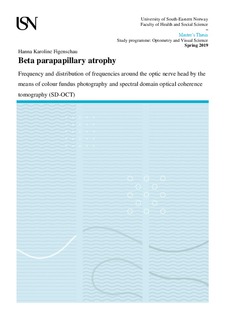| dc.contributor.author | Figenschau, Hanna Karoline | |
| dc.date.accessioned | 2019-08-30T13:32:05Z | |
| dc.date.available | 2019-08-30T13:32:05Z | |
| dc.date.issued | 2019 | |
| dc.identifier.uri | http://hdl.handle.net/11250/2611901 | |
| dc.description.abstract | Purpose: The purpose of the study was to investigate the prevalence and distribution of frequencies of beta parapapillary atrophy and its distal border around the optic nerve head identified by the means of colour fundus photographs and SD-OCT.
Methods: 135 eyes of 68 subjects with mean age of 61.33 years (range: 43-81, SD:
9.68) was included. Subjects underwent anamnesis and a standard optometric examination with dilated imaging of colour fundus photography and SD-OCT in both eyes. Fundus photographs was marked regarding presence of beta parapapillary atrophy and its distal border. IR-images with markings of OCT-defined distal border of beta parapapillary atrophy was overlaid fundus photos digitally before further analyses.
Results: Prevalence of beta parapapillary atrophy by means of fundus photography was
23.4% (CI: 13.0, 33.8) in right eyes and 27.0% (CI: 16.0, 38.0) in left eyes with an insignificant difference between eyes (p= 0.550). Prevalence of beta parapapillary atrophy in both eyes was 21.7% (CI: 11.3, 32.1). The atrophy was most prevalent in temporal region, decreasing in inferior region before superior region, towards least frequent nasal region. The distribution of frequencies by means of SD-OCT corresponded with that of fundus photographs, but the frequencies in SD-OCT was generally higher. Overlapping distal borders of parapapillary atrophy by means of fundus photo and SD-OCT was most frequent in superior-temporal region in both eyes.
OCT-defined distal border placed on the inside of fundus photo-defined distal border was most frequent in inferior-temporal region in both eyes. OCT-defined distal border placed on the outside of fundus photo-defined distal border was most frequent in superior-temporal region in both eyes. There were much higher frequencies for the
OCT-defined distal border placed on the inside of fundus photo-defined distal border, than the two other outcomes, in both eyes.
Conclusion: The frequency and distribution of frequencies of beta parapapillary atrophy identified by means of fundus photography and SD-OCT was consistent with previous studies. Frequency and distribution of frequencies of beta parapapillary atrophy and its distal border around the optic nerve head was unique for this study and provides further clinical knowledge of parapapillary atrophy when using both image modalities. | nb_NO |
| dc.language.iso | eng | nb_NO |
| dc.publisher | Universitetet i Sørøst-Norge, Fakultet for helse- og sosialvitenskap. Institutt for optometri, radiografi og lysdesign | nb_NO |
| dc.subject | colour fundus photography | nb_NO |
| dc.subject | SD-OCT | nb_NO |
| dc.subject | beta parapapillary atrophy | nb_NO |
| dc.subject | distal border | nb_NO |
| dc.title | Beta parapapillary atrophy : frequency and distribution of frequencies around the optic nerve head by the means of colour fundus photography and spectral domain optical coherence tomography (SD-OCT) | nb_NO |
| dc.type | Master thesis | nb_NO |
| dc.rights.holder | © 2019 Hanna Karoline Figenschau | nb_NO |
| dc.source.pagenumber | 70 s., vedlegg | nb_NO |
